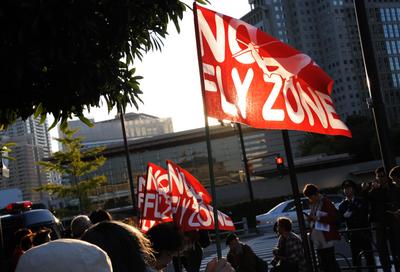An alleged sexual assault by two US sailors on an Okinawan woman further increased tension on the island.
Okinawa sits over 1500km from Tokyo, halfway between mainland Japan and China. About 70 per cent of the US military deployment in Japan is based in Okinawa, which represents less than 1 per cent of Japan’s total land mass. An overwhelming majority of Okinawans opposes the US presence.
Following the end of the Cold War, Okinawans envisaged a scaling down of the US presence as the risk of war in the region dramatically fell. But as China increases diplomatic pressure, particularly in the East China Sea, Okinawa has become even more strategically important, as evidenced by the US military’s deployment of new aircraft to the Okinawa bases.
For the Marine Corps, the MV-22 Osprey aircraft are simply a necessary upgrade of the ageing CH-46 Sea Knight helicopters. Marines claim the aircraft have a solid safety record and will significantly boost capabilities. But Okinawans consider the Osprey unsafe, citing a crash in Morocco that killed two marines in April and another in June in Florida. For some Okinawans, the Osprey would not be welcome even if its safety were guaranteed.
The resentment felt by Okinawans is not only a product of the relationship between the United States and Japan, but also of the internal relationship between the central government and Okinawa prefecture.
In Okinawa, more than perhaps anywhere else in Japan, history frames the present. Distant memories of independence, followed by an invasion by Satsuma (a feudal domain of Japan) in 1609 and its annexation by Japan in 1872 and the accompanying assimilation policies have resulted in an uneasy relationship between the Okinawan islands and mainland Japan. Events such as the Battle of Okinawa, which saw more than 30 per cent of the population perish and resulted in US rule until 1972, shapes Okinawan identity and its relationship with Tokyo.
This history shows that Okinawa is psychologically remote from Tokyo. Tokyo policy makers consider the US presence in Okinawa to be a necessity given Japan’s constitutional restrictions, but the people of Okinawa view US bases as evidence that they are treated as second-class citizens by their own government.
In Okinawa the strategic justification for the bases is less compelling than it is in Tokyo. Ryukyu culture was significantly influenced by dynasty-era China, resulting in an almost sentimental view of China’s rise. While there is some concern over China’s military build-up and claims to the Senkaku islands, which are considered part of Okinawa Prefecture, the bases remain a greater priority.
The relationship between Okinawa and the US military is also tense. While the US and Japan agreed that the Osprey would ‘avoid flying over densely populated areas’, the aircrafts have passed at low altitude over towns and used their rotors when leaving the base.
There is also a common suspicion that many attacks on Okinawan women go unreported. Okinawans still remember the 1995 gang rape of a 12-year-old and have little faith in the US military justice system, which is perceived as favouring US military personnel. The Okinawan government has called for stricter discipline measures and curfews, but while in the short term this might please the opposition, in the long term the distance and lack of understanding between the Okinawans and US military personnel will likely continue.
Sadly, there is no quick solution. Locals often argue that if bases were scaled back the land could instead be commercialised. Most of the US bases are situated in the flat south, where there are aspirations to develop Okinawa into a regional trade hub, expand tourism and explore other potential industries such as IT call centres.
But there is no consensus over the best use of the land and the private owners of land would have to be compensated. In any case economic revitalisation would take time.
Okinawans will eventually have to accept a solution with some kind of US presence. Many feel uncomfortable suggesting bases relocate to Guam because they understand the burden placed on the host. While relocation of the Futenma base to Henoko is a logical compromise, Okinawans are reluctant to accept any new US bases. Opposition to the US presence has almost become part of Okinawan identity.
The Okinawa prefectural government has no negotiating power over foreign policy and little sway over Tokyo’s strategy. Nevertheless, Okinawan politicians and civil society groups need to demonstrate they can be part of the solution.
National attention is temporarily focused on Okinawa but as these incidents fade from the headlines the distance between Okinawa and Tokyo will probably continue to grow. The US bases are unlikely to be in Japan forever, unlike the Okinawan people. So in the immediate term, policy makers in Tokyo should pay greater attention to Okinawa. Greater trust between Okinawa and Tokyo will serve everybody’s interests and strengthen the US–Japan alliance.
Vicky Tuke is a Daiwa Scholar. She spent one month living in Okinawa before writing this piece, and is now based in Tokyo.

